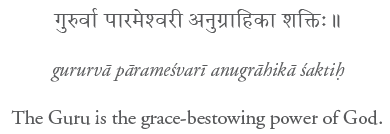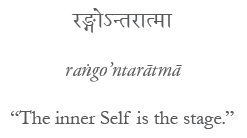In Step with the Heavenly Beat
An Account of Gurumayi’s Birthday Celebration
Shree Muktananda Ashram
June 23 – 24, 2015
Part XI

June 24, 2015—Gurumayi Chidvilasananda’s Birthday!!! What a day! What adjective can accurately describe this day? How do we truly celebrate the auspicious birthday of our Shri Guru, from whom we received shaktipat and from whom new seekers will receive shaktipat?
One of the sages of Kashmir Shaivism writes:

We celebrate Gurumayi’s Birthday with the recognition that Gurumayi is the embodiment of this divine power––whose grace and guidance, whose example and teachings have forever transformed every aspect of our lives and the world in which we live. Jaya Gurumayi!
 When our recitation concluded, the sun had risen in all its glory. Everything in the Ashram looked clear and bright in the fresh morning air.
When our recitation concluded, the sun had risen in all its glory. Everything in the Ashram looked clear and bright in the fresh morning air. I am a dancer myself and am currently an Assistant Professor of Dance at the University of Hawai‘i at Mānoa. Since childhood, I have been very interested in dance as a form of worship, as a way to experience the divine. Through my studies I have learned that throughout Indian history, dance has been one of the main forms of worship offered in temples. The various forms of classical Indian dance that exist today have their roots in these sacred temple dances. Two years ago, in 2013, I had the auspicious opportunity to offer a dance performance during the Celebration Satsang in honor of Gurumayi's Birthday in Shree Muktananda Ashram. Dancing for Gurumayi was one of the most blissful experiences of my life, and an immense honor.
I am a dancer myself and am currently an Assistant Professor of Dance at the University of Hawai‘i at Mānoa. Since childhood, I have been very interested in dance as a form of worship, as a way to experience the divine. Through my studies I have learned that throughout Indian history, dance has been one of the main forms of worship offered in temples. The various forms of classical Indian dance that exist today have their roots in these sacred temple dances. Two years ago, in 2013, I had the auspicious opportunity to offer a dance performance during the Celebration Satsang in honor of Gurumayi's Birthday in Shree Muktananda Ashram. Dancing for Gurumayi was one of the most blissful experiences of my life, and an immense honor.And today I felt even more honored to introduce Lavanya Mavillapalli, a Siddha Yogi from Chennai, India, who would be performing Bharatanatyam as an offering to our beloved Gurumayi. Bharatanatyam, a classical South Indian dance form, tells stories of the divine. Lord Shiva, the primordial Guru, is considered to be the deity of Bharatanatyam.
In preparation for the event, I met with Lavanya and learned that she had been introduced to the Siddha Yoga path by her husband, Aditya, when they married twelve years ago. This was their first seva visit to Shree Muktananda Ashram, along with their seven-year-old son. Lavanya's face shone with love and excitement as she shared with me about the honor she felt in being able to offer her dance performance to Gurumayi on the very day of Gurumayi's Birthday.
Soon participants began to arrive in Anugraha, including several families with young children. To say that the performance space was buzzing with happiness and anticipation is an understatement. How does one capture the joyful movements of the heart in words?
As we were anticipating Gurumayi’s arrival, I suddenly felt an unmistakable surge of energy fill the room, as if a shower of love had fallen from heaven as a blessing to the earth. I saw Gurumayi entering the space. Everyone immediately rose to their feet and exclaimed, “Happy Birthday, Gurumayi!”
After Gurumayi took her seat, in my role as the host I explained to everyone how we would be celebrating Gurumayi’s Birthday with Gurumayi, and that we were being treated to something very special: a sacred dance, a form of worship that has been handed down from teacher to student for generations in India.
I introduced Lavanya, sharing that she has been dancing since the age of three. Her parents are both famous dancers, proficient in two of the eight classical Indian dance forms: Bharatanatyam and Kuchipudi. They are still performing all over the world.
I invited Aditya, Lavanya’s husband, to introduce the dance. Aditya has been following the Siddha Yoga path since he was a child. He offers seva as a Siddha Yoga musician, playing the mridang for namasankirtanas. His whole being radiated the joy of making this oblation to Gurumayi.
He said: “Bharatanatyam is a sacred offering; it is worship of the divine. Through this worship, we are invoking the presence of the divine in our lives. When the intention of the performers and the intention of the audience are to recognize the divinity in every subtle movement of the dance, then each one of us can come closer to our own inner divinity.”
Lavanya stepped onto the stage as Aditya continued, “This dance celebrates the divine mother, Adi-Shakti, and extolls her many attributes.
- As Raja Rajeshwari, she is the empress of the universe.
- As Ardha Nareshwari, she is the dynamic manifestation of the primordial energy emanating from the eternal stillness of Lord Shiva.
- And as Annapurneshwari, she is the goddess who appeases hunger, be it the physical need of the body or the soul’s hunger for awakening.”
As Aditya spoke, Lavanya represented the attributes he was describing through dance movements.
Aditya concluded his introduction and took his seat. Lavanya reverently brought her hands together to offer pranam to Gurumayi. Everyone was enthralled—the transcendent beauty of the devis was already shining through Lavanya. We heard the opening strains of music. And then—the dancer began to dance. Unearthly! Every movement was impeccable in its precision and grace. Lavanya wore ankle bells, so every tap of her feet on the floor echoed with a silvery jingling. With each turn of her head, each hand gesture, each movement of her eyes, Lavanya wove a captivating story. The beauty of her hands as she moved them from left to right in mudras as ancient as the sacred rivers of India brought tears to my eyes. I thought of the untold generations of dancers who had enacted this same story, invoking the sacred energy of the Goddess.
Deft, graceful, fluid, her every movement expressed the various rasas of Lord Shiva's cosmic dance—she was by turns fierce, gentle, gracious, loving, enticing. Her complete absorption drew us into the experience. Wherever she gestured, our minds were drawn there; wherever she looked, our eyes followed her penetrating gaze; wherever her body moved, our beings felt the same movement within ourselves. Anyone watching from outside would have thought that we had all rehearsed together. Yes, every one of us was dancing with Lavanya—the power of her artistry was that astounding. Bharatanatyam—Satyam, Shivam, Sundaram—Truth, beauty, auspiciousness.
 The difference between the dancer and those who were witnessing the dance had dissolved. One of my favorite aphorisms from the Shaivite scripture Shiva Sutra is:
The difference between the dancer and those who were witnessing the dance had dissolved. One of my favorite aphorisms from the Shaivite scripture Shiva Sutra is:
At that point, I experienced that Lavanya’s movements were taking place not just on the physical plane, but also in the space of our inner awareness.
After Lavanya’s worship of Adi-Shakti through dance reached its graceful finale, Aditya came forward again and explained that it is traditional for a Bharatanatyam performance to be completed with a mangalam, or benediction. A mangalam is a prayer that seeks blessings for the well-being of all humanity. The song to which Lavanya would be dancing was an homage to Lord Shiva and Goddess Parvati; Lord Brahma, the creator; and the sage Bharata, who gave the world the great gift of dance.
The lyrics for this mangalam were written by Lavanya's mother, and the music was composed by her father.
As the mangalam was drawing to a conclusion, I was mesmerized by how Lavanya's movements mirrored the final rallentando of the music. When the dance and the music had resolved into stillness and silence, Lavanya stood like a goddess with her hands folded in namaste. What a splendid sight to behold! Our hearts experienced joy in its totality, immense gratitude for Gurumayi, and utmost appreciation for the mahaseva Lavanya had offered in celebration of our beloved Guru's birthday. After a profound silence, the room was soon resounding with our standing ovation. I felt that with our applause, particles of beauty were being scattered throughout the world.
 Gurumayi said, “Beautiful. So beautiful,” then touched her forehead tenderly to Lavanya's. This moment of Guru-disciple connection is forever etched in my heart. Love touching love.
Gurumayi said, “Beautiful. So beautiful,” then touched her forehead tenderly to Lavanya's. This moment of Guru-disciple connection is forever etched in my heart. Love touching love.Gurumayi invited Lavanya to return to the center of the stage so that she could be honored on everyone’s behalf for offering this dance performance. Manju Kochhar, Tarun Desai, and one of the young adult Siddha Yoga musicians presented shawls to Lavanya, Aditya, and their young son. Their son also received a gift bag with a magnificent elephant stuffie from Gurumayi. There is a beautiful story that goes with this. I’ll let you wonder what it might be... ☺ The family received these gifts from Gurumayi and everyone with sweetness and humility.
Lavanya later shared with me that she felt Gurumayi had given her enough for more than one lifetime. I knew exactly what she meant. Every heart in Shree Muktananda Ashram was dancing in step with the heavenly beat. And I felt sure in my heart that every Siddha Yogi in the global sangham felt the power of this offering of Bharatanatyam to the Beloved. Now when I move, I know it is an offering to my Guru. When I sit still, I know it is an offering to my Guru. Gurumayi teaches me daily: life is a celebration of love. So every day, I smile, I dance, I offer, I live. Love is eternal.
2 Shiva Sutra 3.10








